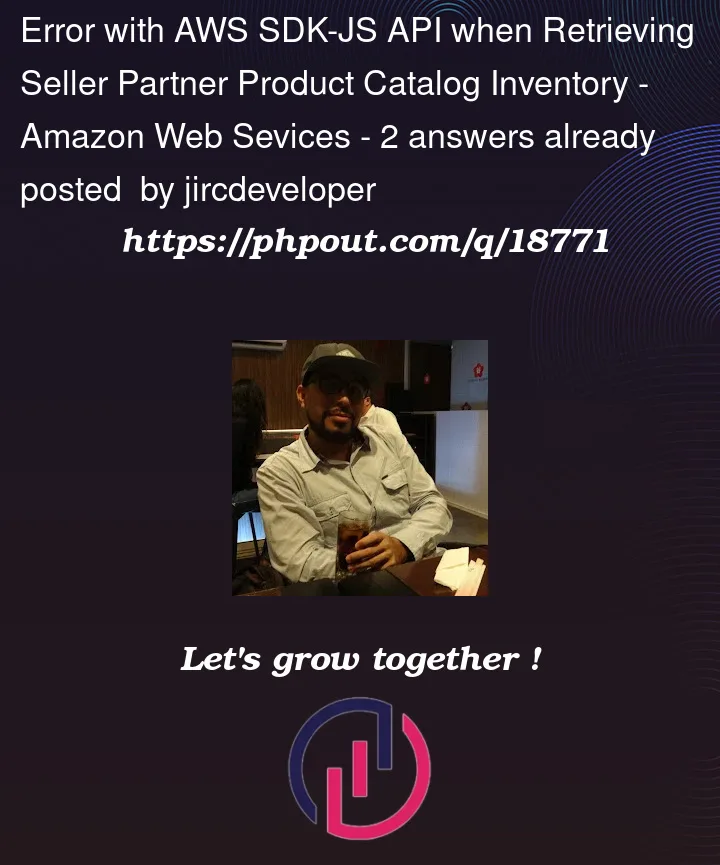I need to retrieve the product catalog of my seller partner on Amazon. Although the API refers to this as "Inventory," I couldn’t find this term in the SDK documentation. I assume that the "Catalog" namespace is the equivalent.
Update:
My custom application requires a list of the following product values:
ASINs
UPCs
SKUs
FNSKUs
I have read the documentation and found an API that returns what I need, which can be found here:
https://developer-docs.amazon.com/sp-api/docs/fba-inventory-api-v1-use-case-guide
According to the documentation, I need to create a signature in order to use the API. However, it is noted that if I use the AWS SDK, I do not need to calculate the signature myself. Therefore, I understand that the best practice is to use the AWS SDK.
I have the necessary IAM role permissions and the SP-API app has been published. I am currently attempting to use the AWS SDK.
I have made some changes based on recommendations, but I am not completely sure what else I need to do. Here is my current code:
```
export const /*bundle */ start = async () => {
const client = new MarketplaceCatalogClient({
region: REGION,
credentials: {
accessKeyId: ACCESS_KEY_ID,
secretAccessKey: ACCESS_SECRET_KEY,
},
});
const params = {
/** input parameters */
};
const answer = await client.send(
new ListEntitiesCommand({ Catalog: "AWSMarketplace", EntityType: "ContainerProduct" })
);
console.log(100, answer);
return answer;
};
```
I got the next answer with "AmiProduct" or "ContainerProduct":
{
'$metadata': {
httpStatusCode: 200,
requestId: '91fc5fed-6cdc-42d6-97ec-1ed3cc9d5796',
extendedRequestId: undefined,
cfId: undefined,
attempts: 1,
totalRetryDelay: 0
},
EntitySummaryList: []
}
I’m having difficulty understanding how to correctly implement this. Any guidance would be greatly appreciated.




2
Answers
The docs should be better. I spent a good 15 mins on the docs at https://docs.aws.amazon.com/marketplace-catalog/latest/api-reference/welcome.html and failed to find a full list of valid
EntityTypevalues.Some EntityType values are documented here: https://docs.aws.amazon.com/marketplace-catalog/latest/api-reference/seller-products.html
It looks like these types correspond to the product types in the index of the seller guide here -> https://docs.aws.amazon.com/marketplace/latest/userguide/machine-learning-products.html. It’s not clear what the other valid values are.
Some other EntityType values are documented here: https://docs.aws.amazon.com/marketplace-catalog/latest/api-reference/private-marketplace.html
It looks the way to go for now is to scrounge these valid values from examples in the docs https://docs.aws.amazon.com/marketplace-catalog/latest/api-reference/welcome.html. Not the best developer experience :grimace:
Assuming you are a seller, that you have registered successfully with your AWS account. You can then use Marketplace APIs.
To use them, you have to create an IAM role or a user with policies to grant access to invoke the selected APIs like
listEntities,describeEntity, etc.Here I again assume you have the Cognito authorized credentials if using AWS SDK.
Now to view the list of products successfully published, you use
listEntitescommand.It uses minimum two required parameters
CatalogandEntityType. The former has a fixed valueAWSMarketplace, and latter can have a value eitherAmiProductorContainerProduct.To get a detailed information about a specific product, you use
describeEntitycommand. It takes minimum 2 required parametersCatalogandEntityID.The former again has a fixed value
AWSMarketplace. For latter, you’ll obtain it from thelistEntitesresponse.